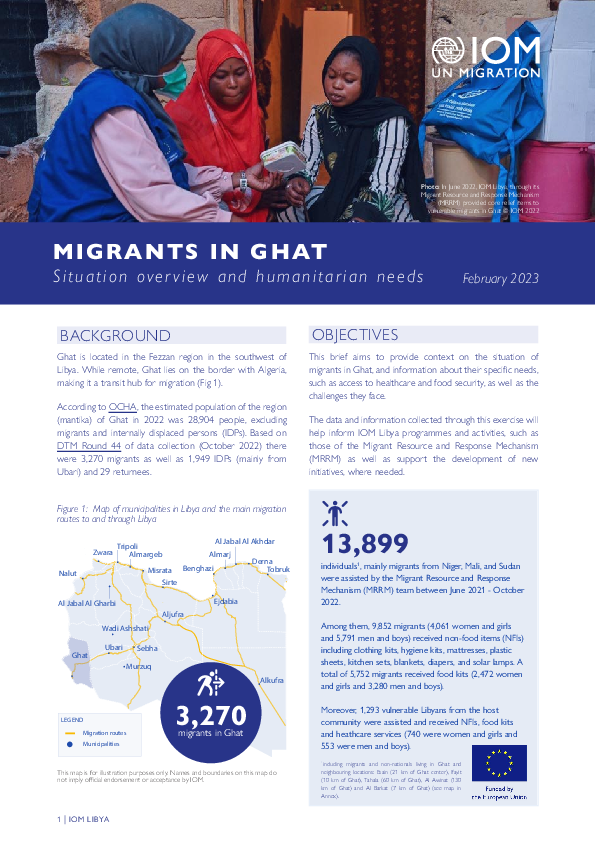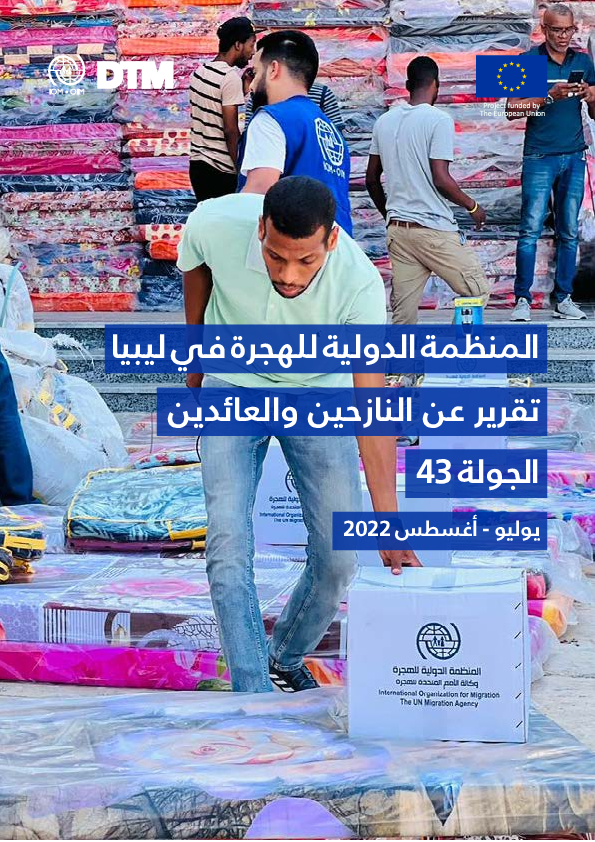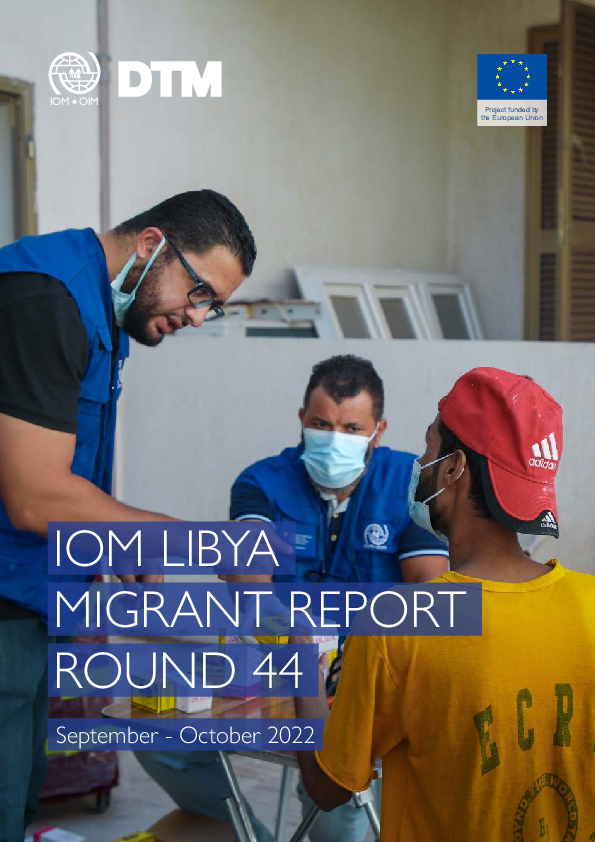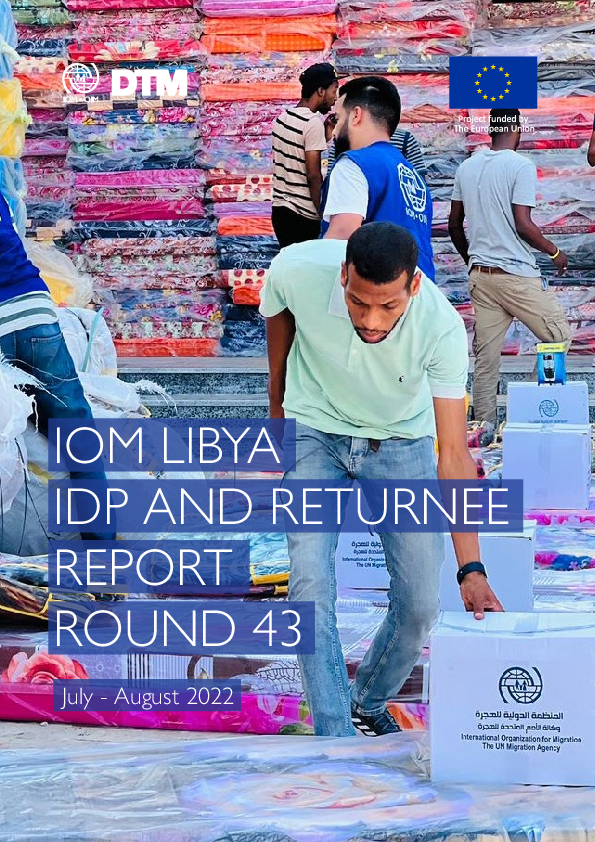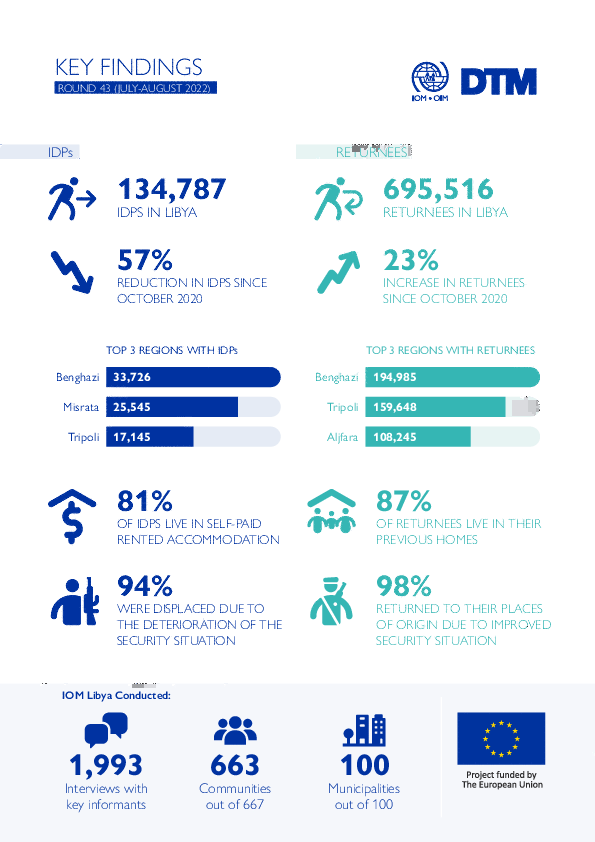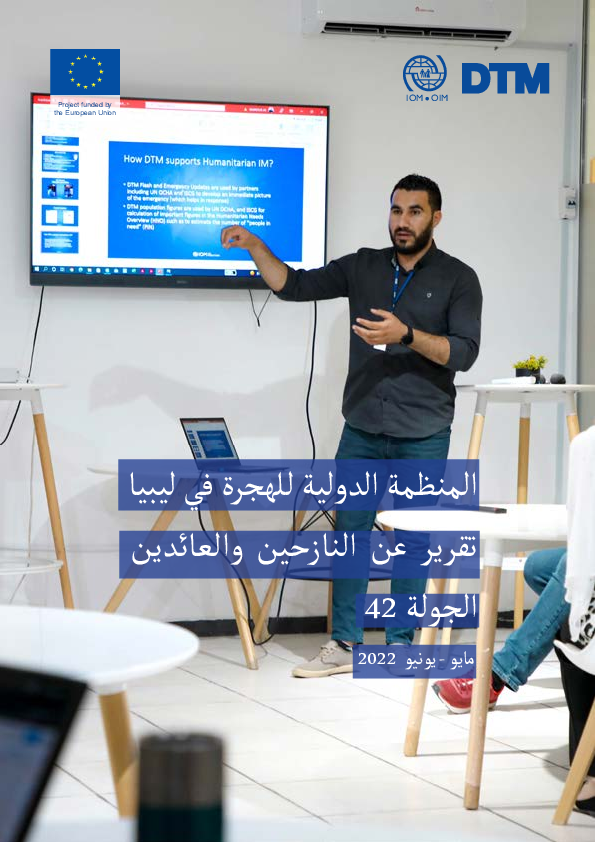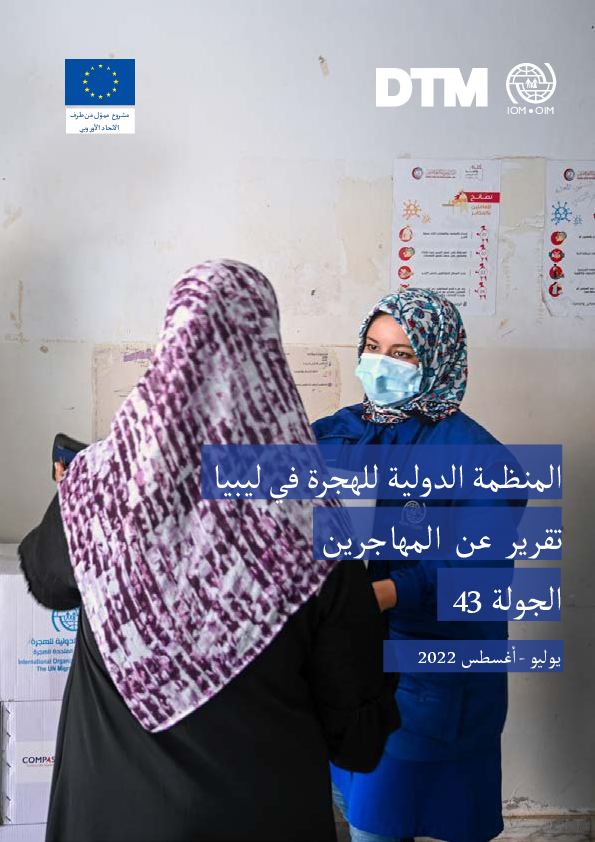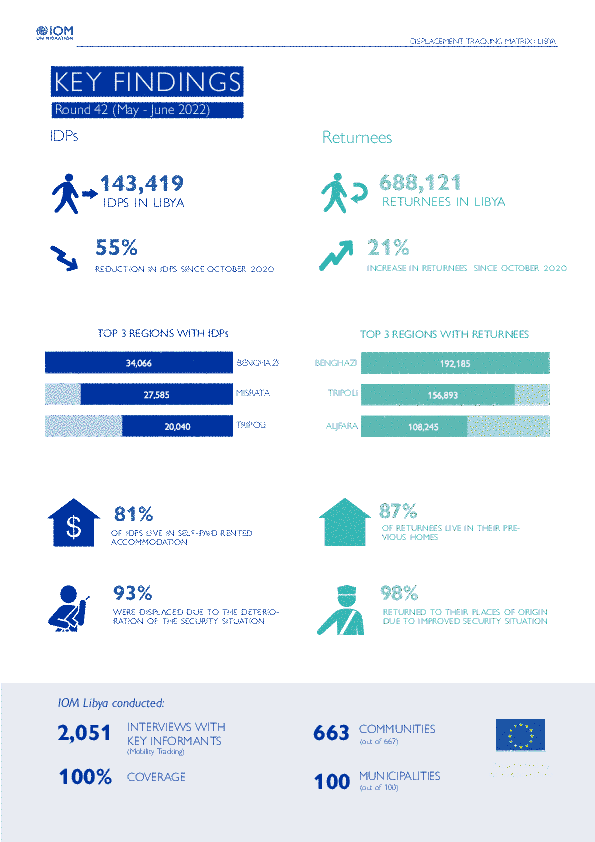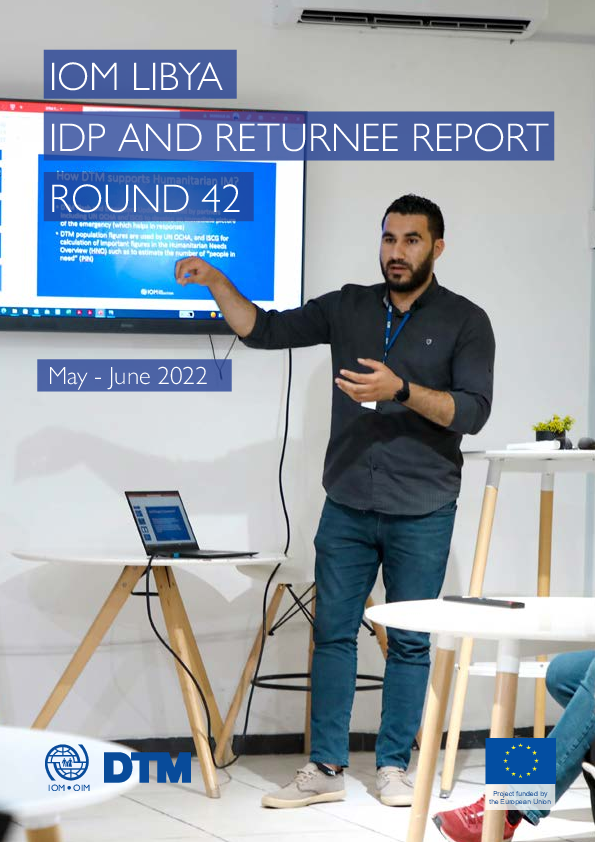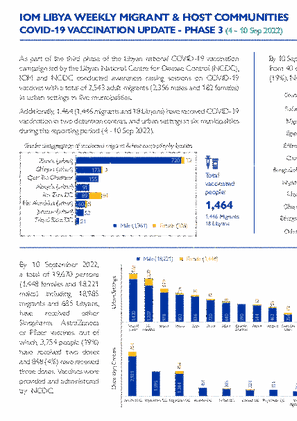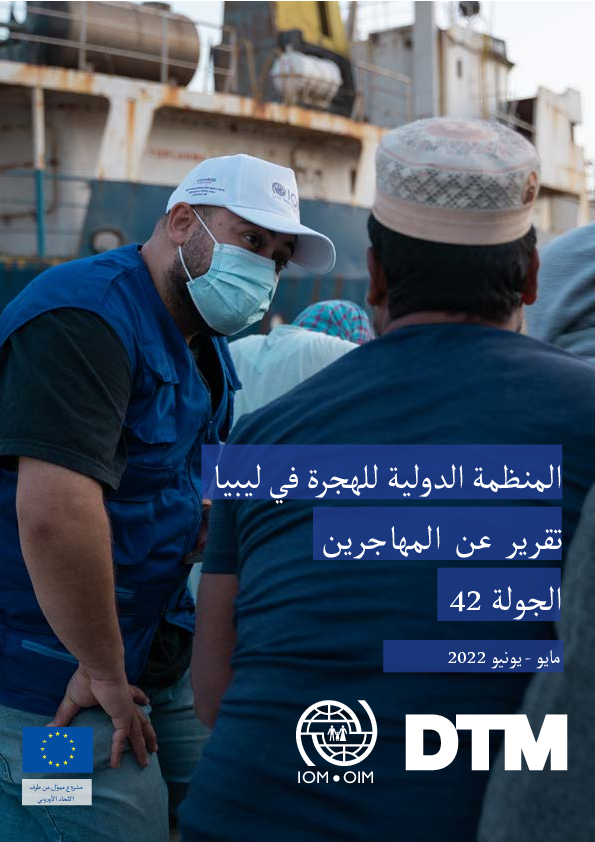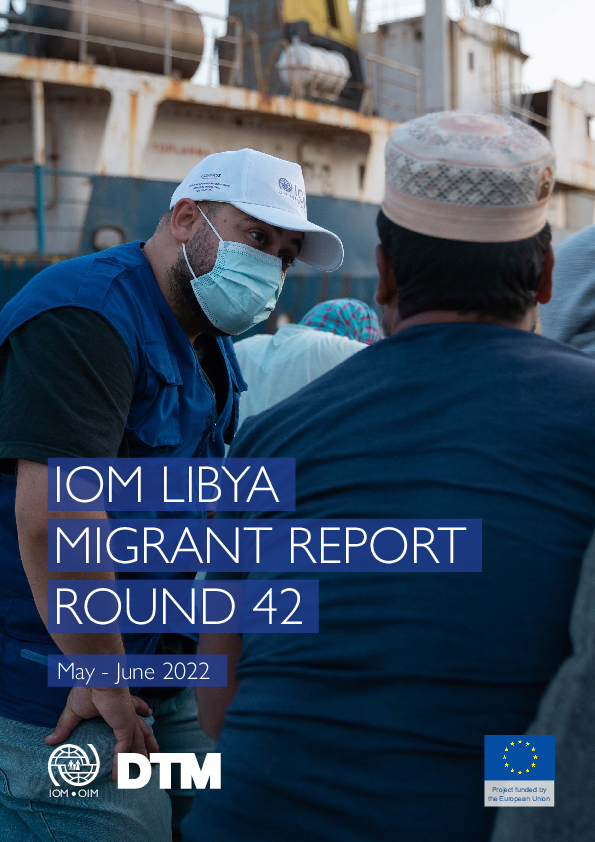-
Countries
-
Data and Analysis
-
Special Focus
-
Crisis Responses
Libya
Sobre Libya
Libya is a geographically vast country with several regions that are difficult to access. In order to understand the full scope of humanitarian assistance that is needed throughout the country, IOM established the Displacement Tracking Matrix (DTM) programme in 2016 in order to provide a common operating picture concerning the movement of populations in Libya, allowing humanitarian actors to provide timely assistance to those in need. Following the escalation of conflict and insecurity in 2014, the security situation has remained volatile since with fluctuations in the intensity of localized clashes. Congruently, conflict has caused new displacements, often in areas ill-equipped to accommodate large population movements while also negatively impacting the large migrant population residing and transiting through Libya. More recently, the capital Tripoli was heavily affected by displacement waves in September 2018 and April 2019.
DTM’s mobility tracking and flow monitoring activities identified many migrants in-country to be in need of various forms of assistance. Libya’s geographic location, resources and work opportunities has made it both a country of destination and transit for migrants for many years. Despite the deterioration of the security situation since 2011 migrants continue coming to and transiting through Libya, the majority from Sub-Saharan and North African countries.
In this complex operating environment, DTM Libya has been providing a common operating picture concerning the movement of populations in Libya since 2016, allowing humanitarian actors to provide timely assistance to those in need. Through its mobility tracking, flow monitoring and needs assessment activities, DTM Libya has established itself as data hub for quantitative data on migratory flows to and within Libya, migrant presence in Libya disaggregated by nationality and area, as well as humanitarian needs of migrants, internally displaced population and returnees. All activities are implemented through periodical bi-monthly data collection cycles, allowing trend analysis over time to provide evidence-base for both policy-level discussions and to guide humanitarian action.
In order to facilitate humanitarian interventions, DTM works closely with IOM’s other programmes through referring identified populations in need of assistance at flow monitoring points to IOM’s Direct Assistance, Health, Voluntary Humanitarian Return (VHR), Protection and Migrant Rapid Response Mechanism (MRRM) programmes. Furthermore, DTM Libya supports other humanitarian partners through providing emergency tracking updates in case of sudden population movements as well as facilitating humanitarian assessments for the Rapid Response Mechanism (RRM) jointly implemented by IOM, UNICEF, WFP and UNFPA.
For more information on IOM's activities in Libya, please visit the IOM Libya country office website.
Contacto
DTM Libya
DTMLibya@iom.int
Current Donors
- EUTF
Para obtener resultados de búsqueda más avanzados, vaya a la Página de búsqueda avanzada de informes
Libya — Egyptian Migrant Workers in Libya: General Overview and Opportunities for the Future [ARABIC]
يتمثّل الهدف من هذه الورقة في تقديم لمحة عامّة عن هجرة العمالة المصريّة إلى ليبيا، مع التّركيز على الفرص المتعلّقة بتحسين إدارة هجرة اليد العاملة بين مصر وليبيا.
Libya — Migrants in Ghat: Situation overview and humanitarian needs (February 2023)
This brief aims to provide context on the situation of migrants in Ghat, and information about their specific needs, such as access to healthcare and food security, as well as the challenges they face. The data and information collected through this exercise will help inform IOM Libya progra
Libya — Detention Centre Profile Generator (January 2023)
Detention Centre Profiling is a component of IOM Libya’s Displacement Matrix programme. It is a data oriented tool that routinely provides specific sex and age demographic data and key sectorial information on individuals held in Libya’s detention centres on the date of assessment.
Libya — IDP and Returnee Report 43 (July - August 2022) [Arabic]
يعـرض تقريـر مصفوفـة تتبـع النـزوح الخاصـة بالمنظمة الدوليـة للهجـرة البيانـات والمسـتخلصات حـول النازحيـن داخليـا والعائديـن فيمـا بيـن شـهري يوليـو وأغسـطس مـن سـنة 2022 وفـي إطـار الجولـة 43 مـن تتبـع التنقـل فـي ليبيـا.
Libya — Migrant Report 44 (September - October 2022)
IOM Libya’s Displacement Tracking Matrix (DTM) programme identified a total of 683,813 migrants from over 42 nationalities in the 100 Libyan municipalities during Round 44 of data collection (September - October 2022).
Migrant Report Key Findings 44 (September - October 2022)
This infographic presents the key findings of Round 44 of the mobility tracking component of the Displacement Tracking Matrix (DTM) programme in Libya.
Libya — IDP and Returnee Report 43 (July - August 2022)
This IOM Displacement Tracking Matrix (DTM) report presents the data and findings on internally displaced persons (IDPs) and returnees between July – August 2022, representing Round 43 of the DTM Mobility Tracking in Libya.
Libya — IDP and Returnee Key Findings Report 43 (July-August 2022)
This infographic presents the key findings of Round 43 of the mobility tracking component of the Displacement Tracking Matrix (DTM) programme in Libya.
Libya — Detention Centre Profile Generator (December 2022)
Detention Centre Profiling is a component of IOM Libya’s Displacement Matrix programme. It is a data oriented tool that routinely provides specific sex and age demographic data and key sectorial information on individuals held in Libya’s detention centres on the date of assessment.
Libya — Detention Centre Profile Generator (November 2022)
Detention Centre Profiling is a component of IOM Libya’s Displacement Matrix programme. It is a data oriented tool that routinely provides specific sex and age demographic data and key sectorial information on individuals held in Libya’s detention centres on the date of assessment.
Libya — Detention Centre Profile Generator (October 2022)
Detention Centre Profiling is a component of IOM Libya’s Displacement Matrix programme. It is a data oriented tool that routinely provides specific sex and age demographic data and key sectorial information on individuals held in Libya’s detention centres on the date of assessment.
Libya — IDP and Returnee Report 42 (May - June 2022) [Arabic]
يعرض تقرير مصفوفة تتبع النزوح الخاصّة بالمنظمة الدولية للهجرة البيانات والمستخلصات حول النازحين داخليا والعائدين فيما بين شهري مايو ويونيو من سنة 2022 وفي إطار الجولة 42 من تتبع التنقل في ليبيا. وقد تواصل عدد النازحين داخليا في البلاد في الانخفاض خلال فترة الدراسة، حيث ت
Libya — Migrant Report 43 (July—August 2022) [Arabic]
في إطار الجولة 43من تجميع البيانات (يوليو - أغسطس 2022)، أحصى مشروع مصفوفة تتبع النزوح في ليبيا الخاص بالمنظمة الدولية للهجرة وجود إجمالي 679.974 مهاجرا ينحدر أصلهم من أكثر من 41جنسية وذلك في بلديات ليبيا الـ100.
Migrant Report Key Findings 43 (July — August 2022)
This infographic presents the key findings of Round 43 of the mobility tracking component of the Displacement Tracking Matrix (DTM) programme in Libya.
Libya — Migrant Report 43 (July—August 2022)
IOM Libya’s Displacement Tracking Matrix (DTM) programme identified a total of 679,974 migrants from over 41 nationalities in the 100 Libyan municipalities during Round 43 of data collection (July - August 2022).
Oct 31 2022
Libya — Migrant Report 43 (July—August 2022)
Libya — IDP and Returnee Key Findings Report 42 (May - June 2022)
This infographic presents the key findings of Round 42 of the mobility tracking component of the Displacement Tracking Matrix (DTM) programme in Libya.
Libya — IDP and Returnee Report 42 (May - June 2022)
This IOM Displacement Tracking Matrix (DTM) report presents the data and findings on internally displaced persons (IDPs) and returnees between May – June 2022, representing round 42 of the DTM Mobility Tracking in Libya.
Libya — Detention Centre Profile Generator (September 2022)
Detention Centre Profiling is a component of IOM Libya’s Displacement Tracking Matrix programme. It is a data oriented tool that routinely provides disaggregated sex and age data and key sectoral information on migrants in Libya’s detention centres on the date of assessment.
Libya — Weekly Migrant and Host Communities COVID-19 Vaccination Update - Phase 3 (4 - 10 Sep 2022)
As part of the third phase of the Libyan national COVID-19 vaccination campaign led by the Libyan National Centre for Disease Control (NCDC), IOM and NCDC conducted awareness raising sessions on COVID-19 vaccines with a total of 2,543 adult migrants (2,356 males and 182 females) in urban settings
Libya — Migrant Report 42 (May - June 2022) [ARABIC]
في إطار الجولة 42 من تجميع البيانات (مايو – يونيو 2022)، أحصى مشروع مصفوفة تتبع النزوح في ليبيا الخاص بالمنظمة الدولية للهجرة وجود مجموع 667.440 مهاجرا في بلديات ليبيا الـ100 ينحدر أصلهم من أكثر من 41 جنسية.
Libya — Migrant Report 42 (May - June 2022)
IOM Libya’s Displacement Tracking Matrix (DTM) programme identified a total of 667,440 migrants from over 41 nationalities in the 100 Libyan municipalities during Round 42 of data collection (May - June 2022).Data collected by DTM Libya continues to show an increase in the number of migrants in L
Sep 06 2022
Libya — Migrant Report 42 (May - June 2022)
Migrant Report Key Findings Round 42 (May - June 2022)
This infographic presents the key findings of Round 42 of the mobility tracking component of the Displacement Tracking Matrix (DTM) programme in Libya.
Libya — Detention Centre Profile Generator (August 2022)
Detention Centre Profiling is a component of IOM Libya’s Displacement Matrix programme. It is a data oriented tool that routinely provides specific sex and age demographic data and key sectoral information on individuals held in Libya’s detention centres on the date of assessment.
Libya — Weekly Migrant and Host Communities COVID-19 Vaccination Update - Phase 3 (21 - 27 Aug 2022)
As part of the third phase of the Libyan national COVID-19 vaccination campaign led by the Libyan National Centre for Disease Control (NCDC), IOM and NCDC conducted awareness raising sessions on COVID-19 vaccines with a total of 2,487 adult migrants (2,448 males and 39 females) in urban settings
Pagination
Para obtener resultados de búsqueda más avanzados, vaya a la Página de búsqueda avanzada de conjuntos de datos
Libya - IDPs and Returnees Baseline Assessment Round 20
2018-06-30
A baseline assessment is a sub-component of mobility tracking. It aims to collect data on IDP, migrant or returnee population presence in a defined administrative area of the country.
Libya - Migrant Baseline Assessment Round 19
2018-04-30
A baseline assessment is a sub-component of mobility tracking. It aims to collect data on migrant population presence in a defined administrative area of the country.
Libya - IDPs and Returnees Baseline Assessment Round 19
2018-04-30
A baseline assessment is a sub-component of mobility tracking. It aims to collect data on IDP, migrant or returnee population presence in a defined administrative area of the country.
Libya - Baladiya Profile Generator R19 (March-April 2018)
2018-04-17
A baseline assessment is a sub-component of mobility tracking. It aims to collect data on migrant population presence in a defined administrative area of the country.
Libya - IDP And Returnee Dataset R19 (March-April 2018)
2018-04-17
A baseline assessment is a sub-component of mobility tracking. It aims to collect data on migrant population presence in a defined administrative area of the country.
Libya - IDPs and Returnees Baseline Assessment Round 18
2018-03-31
A baseline assessment is a sub-component of mobility tracking. It aims to collect data on IDP, migrant or returnee population presence in a defined administrative area of the country.
Libya - Migrant Baseline Assessment Round 18
2018-03-31
A baseline assessment is a sub-component of mobility tracking. It aims to collect data on migrant population presence in a defined administrative area of the country.
Libya - Migrant Baseline Assessment Round 17
2018-02-15
A baseline assessment is a sub-component of mobility tracking. It aims to collect data on migrant population presence in a defined administrative area of the country.
Libya - IDPs and Returnees Baseline Assessment Round 17
2018-02-04
A baseline assessment is a sub-component of mobility tracking. It aims to collect data on IDP, migrant or returnee population presence in a defined administrative area of the country.
Libya — Migrant Baseline Assessment — Round 16
2017-12-31
A baseline assessment is a sub-component of mobility tracking. It aims to collect data on migrant population presence in a defined administrative area of the country.
Libya - IDPs and Retuenees Baseline Assessment Round 16
2017-12-31
A baseline assessment is a sub-component of mobility tracking. It aims to collect data on IDP, migrant or returnee population presence in a defined administrative area of the country.
Libya - IDPs and Returnees Baseline Assessment Round 15
2017-11-30
A baseline assessment is a sub-component of mobility tracking. It aims to collect data on IDP, migrant or returnee population presence in a defined administrative area of the country.
Libya - Migrant Baseline Assessment Round 15
2017-11-30
A baseline assessment is a sub-component of mobility tracking. It aims to collect data on migrant population presence in a defined administrative area of the country.
Libya - IDPs and Retunrees Baseline Assessment Round 14
2017-10-31
A baseline assessment is a sub-component of mobility tracking. It aims to collect data on IDP, migrant or returnee population presence in a defined administrative area of the country.
Libya - Migrant Baseline Assessment Round 14
2017-10-30
A baseline assessment is a sub-component of mobility tracking. It aims to collect data on migrant population presence in a defined administrative area of the country.
Libya - Migrant Baseline Assessment Round 13
2017-09-30
A baseline assessment is a sub-component of mobility tracking. It aims to collect data on migrant population presence in a defined administrative area of the country.
Libya - Migrant Baseline Assessment Round 12
2017-08-31
A baseline assessment is a sub-component of mobility tracking. It aims to collect data on migrant population presence in a defined administrative area of the country.
Libya - IDPs and Returnees Baseline Assessment Round 13
2017-08-26
A baseline assessment is a sub-component of mobility tracking. It aims to collect data on migrant population presence in a defined administrative area of the country.
Libya - Migrant Baseline Assessment Round 11
2017-07-31
A baseline assessment is a sub-component of mobility tracking. It aims to collect data on migrant population presence in a defined administrative area of the country.
Libya - IDPs and Returnees Baseline Assessment Round 12
2017-07-29
A baseline assessment is a sub-component of mobility tracking. It aims to collect data on migrant population presence in a defined administrative area of the country.



